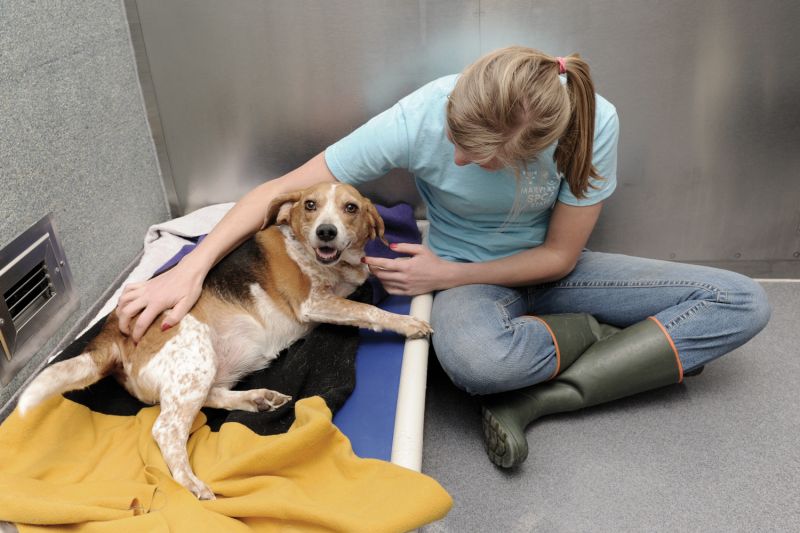Taking the fear out of sheltering
Online course aims to transform how shelters make animals (and people) feel

The pace in many shelters and veterinary practices is fast. As a young veterinarian, I was taught to “just get things done as quickly as possible.” When the workload was heavy, getting everything done efficiently sometimes meant holding down an animal for a vaccine, scruffing a cat or grabbing a dog by the collar and pulling him out of a cage. This is the way many of us are taught to do things in the course of a busy day of working with animals.
While I understood the need to get things done, I wanted a different, gentler way. Before long, I started carrying treats with me in the clinic and in the shelter, and I would try different techniques to calm nervous animals. In fact, the veterinary students sometimes called me Dr. Cookie—and many thought I was just a little crazy for being so concerned about using a gentle approach.
It turns out that veterinarian Marty Becker, founder of the Fear Free initiative, had similar concerns, and when he heard I was of like mind, he asked if I would lead the initiative’s shelter course. I jumped at the chance to participate.

Fear Free was founded in 2016 with the mission to prevent and alleviate fear, anxiety and stress in pets by inspiring and educating the people who care for them. By empowering shelter and rescue staff to apply broad concepts, strategies and techniques, we can reduce fear and frustration in humans and animals alike.
Fear Free is based on the knowledge that a gentle approach isn’t just kinder; it actually promotes better health. Stress, fear and frustration can lead to suppressed immunity, increased risk of infectious disease, behavior problems and welfare issues for shelter animals.
Fear Free is based on the knowledge that a gentle approach isn’t just kinder; it actually promotes better health.
We all know that admission to an animal shelter is stressful for dogs and cats. They commonly experience feelings of fear, anxiety and frustration as a result of entering and being confined in such an unfamiliar environment. They aren’t choosing to be difficult or misbehaving out of spite.
We also know that shelter work can be very stressful for people. It’s upsetting to see animals who are afraid, unhappy and freaked out. The stress of one animal affects other animals, and it affects us, too. And these negative emotions affect both how we feel and how we behave.
Learning how to better recognize the signs of fear, anxiety, stress and frustration and how to apply simple, practical means to prevent and decrease them are crucial to creating positive change in animal shelters—and that’s what the Fear Free Shelter Program is all about.
Fortunately, dogs and cats make this easy for us. They are constantly telling us how they feel via a stream of signals. The most obvious involve changes in their body postures and vocalizations. For example, they may cower, tremble, growl or attempt to run away if they are frightened. When they’re feeling upset, they also communicate passively by withdrawing from normal behaviors, such as eating and grooming. When animals feel good, they display a variety of normal behaviors, including eating, playing, exercising, being social and restful sleeping.
Recognizing and understanding the signs of fear, anxiety, stress and frustration is the first important step to helping animals feel better in the shelter. The second important step is effective communication with people—those who bring animals to the shelter, potential adopters and the entire sheltering team.
There are four core skills that Fear Free teaches as ways to make human communication more effective: using positive nonverbal communication, asking open-ended questions, practicing reflective listening, and showing empathy and understanding.
To use a considerate approach with animals, we must understand and think about how they’re likely to perceive our actions and their environment.
The value of being considerate
When we’re considerate, we’re aware of how our words and actions might make someone feel—so we’re deliberate in what we say and do. This is easy enough to understand when we’re talking about people, but what exactly does this mean with animals?
To use a considerate approach with animals, we must understand and think about how they’re likely to perceive our actions and their environment. The ways they see, hear, smell, taste and experience touch are all very different from ours. Because of this, they truly experience the world differently, and the way they perceive the world affects their emotions and behavior.
Consider this: Dogs and cats are highly sensitive to motion, and rapid movements may increase fear. They have greater peripheral vision and may see things around them that we don’t realize. They have a keen sense of hearing and are sensitive to loud noises. They may hear things we do not, and they’re affected by the sounds of other animals. With their keen sense of smell, they’re much more sensitive to odors than we are. The smell of tasty treats can make them feel better. Strong chemical odors or pheromones from other animals may make them anxious.
Their sense of taste makes certain treats pleasant and rewarding. Their sense of touch means they tend to relax with slow, steady petting and massage. They have sensitive areas where they may not enjoy being touched, such as their feet, around their eyes and mouth, near their genitals and sometimes on their bellies. Finally, they have a sense of personal space. They may feel threatened if we lean over them, approach them head on or get too close too fast. This is especially true if more than one person is approaching them or leaning over them, or if they feel surrounded.
With animals, a considerate approach should be calm and purposeful. Instead of approaching an animal quickly head on, approaching slowly from the side can make all the difference in how they respond. Gazing off to one side is much more considerate because direct eye contact is threatening to both dogs and cats. When handling animals, avoid overwhelming them with too many people. For shy or anxious animals, avoid handling by strangers as much as possible. A familiar caregiver will go a long way toward reducing their stress.
A considerate approach also involves making the environment feel as calm and safe as possible. This includes minimizing potentially stressful sights, sounds and smells by closing doors, limiting foot traffic and cleaning well between animals. Speaking softly, in calming tones, and playing calming music at a low volume can make a world of difference.

Use restraint with restraint
Imagine how we would feel if a stranger forced us to walk down a strange hallway or to lie down on a cold steel table. Sometimes, simply moving an animal through the shelter is very stressful for them. They may freeze, or they may struggle and fight. They do these things because they often feel threatened and vulnerable when they are physically handled, especially by strangers. They are experiencing fear, anxiety and stress. And we can easily make that worse with more forceful handling or restraint, or if we otherwise react harshly or with anger.
The goal of gentle control is to minimize fear and keep animals comfortable as we move them or perform necessary procedures. With gentle control, if an animal struggles or begins to lash out defensively, we stop what we are doing, take a step back, try to help them calm down, and regroup and adjust as needed.
The goal of gentle control is to minimize fear and keep animals comfortable as we move them or perform necessary procedures.
Every little thing that we can do to reduce fear (such as going slow, lowering the volume of our voices or visually blocking animals from scary things) will go a long way to help animals adjust and learn to feel good in the shelter. Providing good behavioral care in the shelter includes reducing fear factors, increasing creature comforts and providing considerate, positive, predictable interactions and communication.
Science has taught us that severe stress and fear can lead to lifelong behavior problems and emotional suffering for animals. Thankfully, science has also taught us that there are many simple ways to make a huge difference. By recognizing that fear, anxiety, stress and frustration are serious problems, we can work together to find practical solutions. Fear Free care is truly better care and better welfare for everyone.







